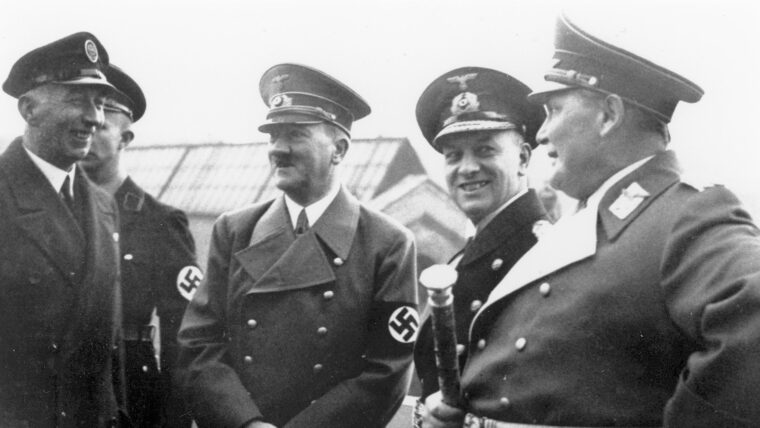
Aircraft carrier
USS Franklin and Father O’Callahan
By Michael D. HullOn March 3, 1945, the 27,100-ton aircraft carrier USS Franklin churned out of Pearl Harbor and headed westward for the war zone. Read more

Aircraft carrier
On March 3, 1945, the 27,100-ton aircraft carrier USS Franklin churned out of Pearl Harbor and headed westward for the war zone. Read more

Aircraft carrier
In November 1941, the U.S. Asiatic Fleet weighed anchor in Shanghai, China, for the last time. Alarmed by the growing hostility and aggressiveness of the Japanese, Admiral Thomas Hart ordered the outnumbered and outgunned American vessels moved to the relative safety of Manila Bay in the Philippines. Read more

Aircraft carrier
In warfare, desperate times call for desperate measures, and in the fall of 1944 the empire of Japan found itself in precisely that predicament. Read more

Aircraft carrier
After two grueling months of action in the Pacific, Vice Admiral John S. “Slew” McCain’s powerful Task Force 38 retired in late November 1944 to the big Caroline Islands base of Ulithi Atoll for a 10-day breather. Read more

Aircraft carrier
An Associated Press report described “a chorus of hisses and boos” that echoed through the chamber when the Congresswoman from Montana cast her vote. Read more

Aircraft carrier
As soon as Colonel James Doolittle’s B-25 raid struck Japan in April 1942, Japan sought to wreak revenge on the United States, but by 1944 devastating aerial bombings on Japan by the Americans had become all too regular. Read more

Aircraft carrier
In early 1942 things could have hardly looked bleaker for the Allies. In Europe, Hitler’s war machine had steamrolled across the entire continent and was now battling before the gates of Moscow. Read more

Aircraft carrier
From an altitude of 30,000 feet, the swift Japanese reconnaissance aircraft flew high over Saipan and Tinian, photographing the brisk and extensive engineering effort under way on the American airfields far below. Read more

Aircraft carrier
Rarely in the history of warfare had one nation absorbed such numbing losses in so rapid a time as did the United States in the Pacific War’s first five months. Read more

Aircraft carrier
When built, the French Surcouf was the largest submarine in the world. She was named for Robert Surcouf, the famed French privateer who waged successful economic warfare against England during the Napoleonic era. Read more

Aircraft carrier
Within hours of the entry of Great Britain and France into World War II on September 3, 1939, the British liner SS Athenia was sunk by a German U-boat off the northwestern coast of Ireland, with the loss of 112 dead, including 28 American citizens. Read more

Aircraft carrier
World War II gave us many stories of aerial warfare, men and their machines fighting their way to victory and glory in the name of humanity. Read more

Aircraft carrier
When she went to the bottom of the sea at the height of the greatest naval battle in history, the USS Gambier Bay (CVE 73) became a legend for heroism and as the only U.S. Read more

Aircraft carrier
The spring of 1941, particularly the month of May, was a troubled time for Great Britain. The German battleship Bismarck had sunk the huge British battlecruiser Hood in just six minutes and was making a getaway to the coast of German-occupied France. Read more

Aircraft carrier
On June 6, 1944, as the massive Allied naval armada made its way from ports in England across the English Channel to launch the projected D-day invasion at Normandy, a German fleet sortie swept down from its home ports on the North Sea and from occupied Norway. Read more

Aircraft carrier
During the 1920s and 1930s Great Britain built up its Far East defenses steadily if slowly, centering around Singapore as its primary naval base in the Pacific area. Read more

Aircraft carrier
On the eve of the turning point of World War II in the South Pacific, the U.S. Navy’s most experienced aircraft carrier commander, Admiral William F. Read more

Aircraft carrier
In addition to standard aircraft carrier and warship patrol operations in the open sea, naval action during the Vietnam War developed a character of its own. Read more

Aircraft carrier
The haggard American sailors aboard the limping cruiser hoped that the journey upon which they had just embarked was the long-expected voyage back to the United States. Read more

Aircraft carrier
When one thinks of carrier warfare in World War II, the Japanese and U.S. navies usually come to mind. Read more